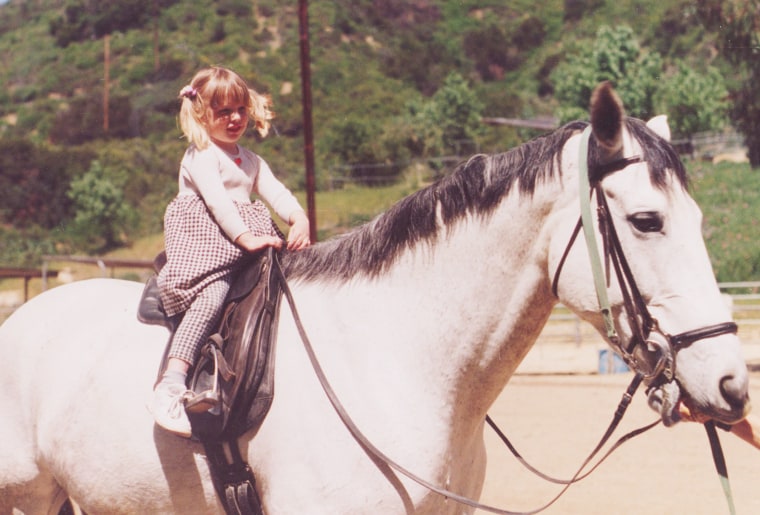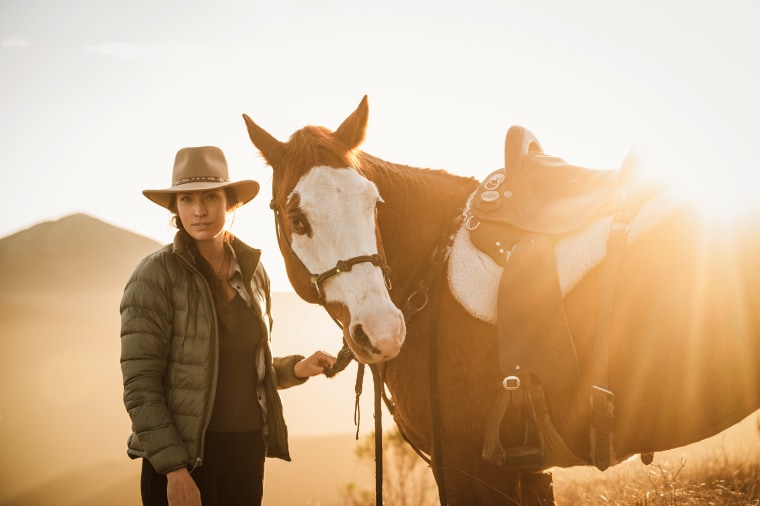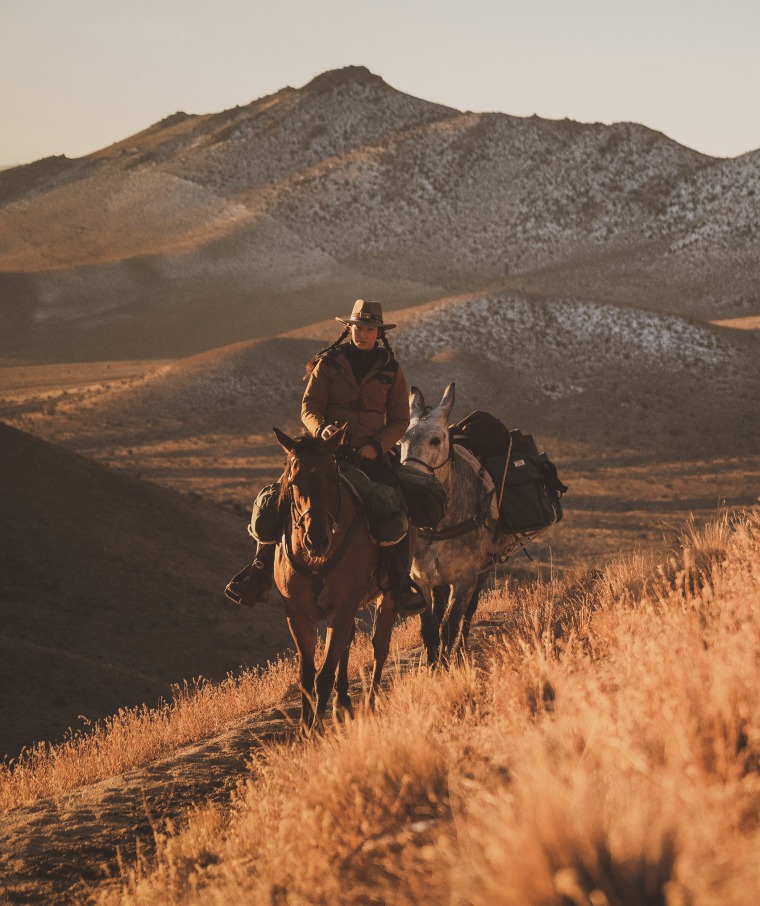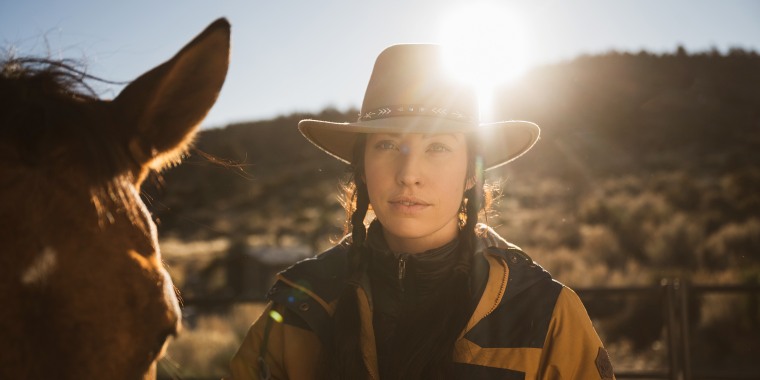We are all works in progress; even the successful women you see owning it on Instagram faced stumbling blocks along the way and continue to work hard to stay at the top of their game. In this series, we're sitting down with the people that inspire us to find out: How'd they do it? And what is success really like? This is "Getting There."
Through the deserts, backcountry and treacherous mountain passes of the West Coast is a trail. It stretches 2,650 miles from the Mexican to the Canadian border. And in 2014, Gillian Larson became the youngest documented woman to ride it alone on horseback.
Thru-riding is the term for the people who mount their horses and see the country in its wildest places by riding long-distance trails. Some of the most famous in the U.S. include the Pacific Crest Trail, or PCT, and the Continental Divide Trail. Larson, a native Californian who's just 29, has ridden both in their entireties, amassing more than 10,000 miles. She first did the PCT at just 22 years old, becoming the youngest woman to do so, and again in 2016.
Some may recognize the trail from the Reese Witherspoon film, "Wild," based on the 2012 memoir by Cheryl Strayed, who thru-hiked 1,100 miles of it.
Larson is an equestrian with a masters in biology who was raised about 45 minutes outside of Los Angeles in Topanga Canyon, California. And while she's accomplished a groundbreaking feat and is being recognized for her achievements, which includes starring in a documentary short film by Firestone Walker, she remains humble and eager for her next quest.
TMRW spoke with Larson about how she discovered her love of horseback riding, how thru-riding has restored her "faith in humanity" and when she's planning to do it all again.
TMRW: When did you first fall in love with horseback riding?

Larson: I got into horseback riding because my mom was a dressage rider. We were always around horses at the barn. She’d help me ride around on a pony at 4 years old. She’d just let me galavant the few hundred-acre boarding facility. It reminds me of freedom and independence, of adventures. Then we’d go on a trail ride. She had a huge dressage horse, I had a little white Shetland pony — they were biggest and the smallest (of all the horses).
I got my first horse at 7. I started riding alone around 12. My mom moved to a place where we could have a horse on our property and I was riding around in Topanga State Park by myself.
TMRW: How old were you when you first did the Pacific Crest Trail?
Larson: I was 22. I went and did it April 4, 2014: That was day one. I rode alone. The riding part, I’ve always done alone. My mom has tried to help when convenient. She helped me for the first 10 days. She would drive out to help me during the weekends. Farther north, I was really on my own.

The second time, I did it on my own during grad school. I’d ride, and then go back to school to teach a class, and then get back on the trail. It's stressful going back and forth. The trail gives zero Fs about your schedule. It's like, "Oh you need to be somewhere? Let me put 100 trees in front of you."
TMRW: What was the longest period you spent on the trail between resupplying, just you and the horse?
Larson: The Sierras — a few hundred miles. I would drop food at pack stations on the trail to resupply. It was about 15 to 20 days.
The trail gives zero Fs about your schedule. It's like, "Oh you need to be somewhere? Let me put 100 trees in front of you."
I'm averaging 600 miles a month on long distanced rides. It usually takes me five months and typically five days between resupplying the horses at my truck. I take breaks between for weather, fires or rain and try to plan the timing around that very small window.
TMRW: What were some of the most challenging things to happen during the ride?
Larson: You always have trail obstacles ... and you never know when they're going to hit. Hikers can navigate the snow much easier than the horses.
Washington always scares the bejeezus out of me. You'll get to points where you start going over trees, the horse starts jumping trees, and then you don’t know if you can go back after you go through. You have scary judgement decisions: "OK, am I going to get us in over our heads? Will we be able to make it back? Am I going to have enough food without going hungry?" There’s this continued anxiety. "Are we going to get into a bad spot and will I be able to get us of it?" It doesn’t ever really go away.

TMRW: What would you describe as your favorite moment of your thru-rides?
Larson: There's a really pretty ridge line I was riding toward, but it was overcast the entire day. I knew how pretty it could be, but that for the 20-something miles that I was riding, it was a gloomy, overcast day.
We got to this ridge line locked in with clouds with 30-feet visibility. All of a sudden, the clouds just dropped. We literally broke through the clouds; the first sun of the whole day. It was like being on an island above the clouds — just my ridge line, and Mount Rainier in the distance. It looked like an ocean of clouds with nothing above us but a blue sky. I was losing my mind with how pretty it was. It was a really magical moment.
TMRW: Accomplishing a feat of this magnitude can have lasting impact. What are some ways you feel this ride changed you?
Larson: It wasn’t an immediate change where I got to the border and felt like I was different. I'm a skeptic. Many people go on this hike for some kind of healing aspect — to transform. I was like, “That’s not me.” It was only once I returned to normal life ... I couldn’t reflect on it until I had done it. It really started to sink in how much I enjoyed that nomadic adventurous lifestyle. I thought, "Oh I can't do it again."

Realizing I could, I began restructuring my life around this hobby. It taught me to value experiences more than other qualities in life. I had other goals and gave them all up to have something that gives you so much fulfillment over, maybe, a 10-year plan to get married and have a house. I found this wasn’t sitting right ... listen to that gut feeling.
You get so many generous moments: a flat tire on a dirt road and someone stops and helps, you need a place to stay and someone offers to host you. You have so many kind moments from complete strangers. It restores your faith in humanity.
On the trails, I never met any crazy people. I've only met nice, kind, amazing people. It restored my faith in the goodness of humanity and made me a lot more willing to talk to strangers. So many women are conditioned to not engage with strangers. When I need help, if I'm hitchhiking, it's usually not a woman picking me up. Women are more nervous to meet a stranger.
It's interesting, because women are conditioned to not engage with strangers so we end up not being the ones to help, because we're self-protecting. We don’t necessarily feel free in our environment. I feel more nervous grocery shopping than in the woods. There's just something about the wilderness that attracts the right people. It's a safe place to set down those conditioned and usual fears we often have about strangers, embrace a different kind of freeing perspective and engage with people without being so suspicious.
TMRW: Now that you’ve become the first to thru-ride the PCT solo, is there something you’d like to do next?
Larson: I'd like to do the PCT again. I miss it. It’s been five years since I've been on the trail. In 2022, I'm hoping to, depending on what kind of snow year California gets — if the snow Gods bless me.

